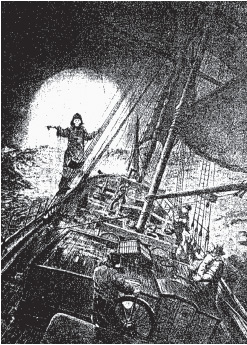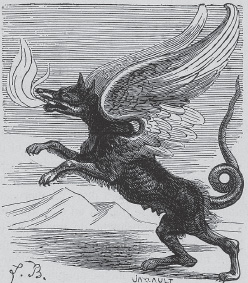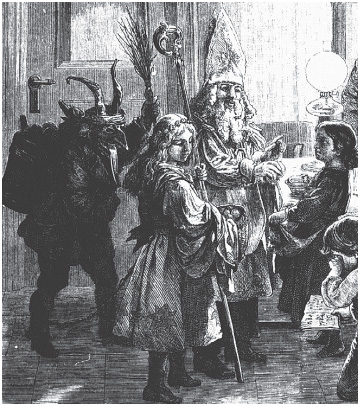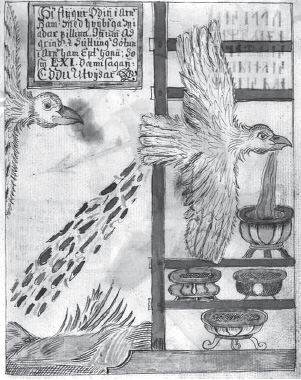K
KÁRA: Reincarnation of the valkyrie Sigrún and protector of Helgi Haddingjaskaði, who is himself the reincarnation of Helgi Hundingsbani, the murderer of King Hundingr.
 VALKYRIE
VALKYRIE
KARI (“Gust”): A giant; the son of Fornjótr.
KASERMAN(N)DL, ALMBUTZ: The name of a spirit that takes possession of the Alpine pastures once animals and men have returned to the valleys. They are often cowherds or shepherds who return because they committed a transgression involving livestock, food, or tools. This is a widespread belief throughout the Alps.
 Alpenburg, Deutsche Alpensagen, no. 74; Vernaleken, Alpensagen, 85.
Alpenburg, Deutsche Alpensagen, no. 74; Vernaleken, Alpensagen, 85.
KASERTÖRGGELEN (pl.): A collective term in the Tyrol that refers to child revenants that are generally harmless although they cannot tolerate curiosity. They will blind anyone who spies on them. They come down from the summer pastures in the Alps on Saint Martin’s Day. Their name means “the Wobblers of the Chalet(s).” They are close relatives to the Kaserman(n)dl.
 Alpenburg, Mythen und Sagen Tirols, 162–62, 169–70, 180; Heyl, Volkssagen, Meinungen und Bräuche aus Tirol, 73.
Alpenburg, Mythen und Sagen Tirols, 162–62, 169–70, 180; Heyl, Volkssagen, Meinungen und Bräuche aus Tirol, 73.
KENNING: Extended metaphors that were quite popular with the Norse skalds (poets) and to which we are indebted for much information on mythology. For example, gold is called “Fróði’s flour,” which refers to the mythical mill owned by Fróði and worked by the two giantesses Fenja and Menja. The sea is called “ymir’s blood,” an allusion to the role of this giant in the creation of the world.
Snorri Sturluson’s Skáldskaparmál (Treatise on the Skaldic Art) is a collection of kennings with explanations, and of heiti.
 HEITI
HEITI
KERAN: God whose name appeared in 848 and who is represented by a spear. It is thought that this weapon represents lightning, and Keran is commonly compared to Wodan.
KERLAUGAR: The name of the two mythical rivers that the god Thor crosses on a daily basis. It is possible that Kerlaugar refers to a myth that has not been preserved for us.
 KÖRMT
KÖRMT
KLAUBAUF: In Tyrolean Christmas processions the Klaubauf is a type of wild man who most often appears in groups. He wears a fur mantle, large bells on his belt, and a terrifying mask. He accompanies Saint Nicholas on his travels through towns and villages, and when the saint enters a house he creates a huge racket outside. Once Saint Nicholas has finished his rounds, the Klaubauf still has full run of the land and behaves very aggressively.
 KNECHT RUPRECHT, KRAMPUS, PERCHT, STAMPA
KNECHT RUPRECHT, KRAMPUS, PERCHT, STAMPA
KLABAUTERMANN, KLABOTERMAN, KALFATER, KLADER: A local land spirit of northern Germany, the Klabautermann is bound to a sailboat over which he keeps watch. If he leaves the ship it will sink. Most of the time he is invisible; on those occasions when he is seen, he appears as a homunculus the size of a bottle with red hair and a white beard. He has light-colored eyes, green teeth, and the face of an old man. He smokes a pipe, is dressed as a sailor, and carries a boatswain’s hammer. He is said to be the spirit of a child who died unbaptized and was buried beneath a tree. His soul thus entered the tree, and when wood from it was used to build a ship, he entered the vessel.
 Gerndt, Fliegender Holländer und Klabautermann; Temme, Die Volkssagen von Pommern und Rügen, no. 253; Karin Lichtblau, “Klabautermann,” in Müller and Wunderlich, eds., Mittelalter Mythen, vol. II, 343–52.
Gerndt, Fliegender Holländer und Klabautermann; Temme, Die Volkssagen von Pommern und Rügen, no. 253; Karin Lichtblau, “Klabautermann,” in Müller and Wunderlich, eds., Mittelalter Mythen, vol. II, 343–52.
KLUDDE, KLEUDDE: A figure that takes many forms who was most likely a water spirit originally. It can be found in Holland, Flanders, and Belgium in a human shape—man, woman, wizard, revenant—or as a devil or nightmare. Its most frequent animal shapes are, in descending order, dog (black and rearing on its hind legs), calf, bear, and cat. Kludde is sometimes a were-creature, a bogeyman, or a perching spirit that makes its victim carry it for a certain distance, or a water spirit.
 Van den Berg, De volkssage in de provincie Antwerpen in de 19de en 20ste eeuw, vol. III, 1539ff.
Van den Berg, De volkssage in de provincie Antwerpen in de 19de en 20ste eeuw, vol. III, 1539ff.

Fig. 40. Klabautermann

Fig. 41. Kludde
KNECHT RUPRECHT (“Servant Ruprecht”): A bogeyman who accompanies Saint Nicholas and carries disobedient children away in his basket. In fact, this figure originally represented a water demon that was Christianized and attached to Saint Nicholas.
He is customarily masked and clad in animal hides, but he can change into a nice old man with white whiskers. He carries a staff that he uses to hit those whom he comes across. He promises to reward good children and to carry away in his sack those who hit their little sisters, or else to eat the bad children. In 1663, Knecht Ruprecht sang:
Ich bin der alte böse Mann
Der alle Kinder fressen kann.
(“I am the old evil man who can eat all the children.”)

Fig. 42. Knecht Ruprecht and Saint Nicholas. Drawing by F. Kollarz, after M. Rumpf, Perchten.
Etymologically, his name means “Radiant Fame,” but because of his appearance and behavior, a folk etymology sees Ruprecht as deriving from Rupel, “hayseed.”
 KLAUBAUF, KRAMPUS, PERCHT, STAMPA
KLAUBAUF, KRAMPUS, PERCHT, STAMPA
 Lecouteux, “Nicchus—Nix,” Euphorion 78 (1984): 280–88.
Lecouteux, “Nicchus—Nix,” Euphorion 78 (1984): 280–88.
KOBOLD: The name of a local land spirit that is attached to various places and has a multitude of names depending on the country and region. He corresponds to the goblin and the gnome. As a household spirit he provides services but also plays all kinds of tricks. He can appear in a variety of guises such as that of a cat, a three-legged pig, or a ball of fire. People pay him for his help with an offering of gruel. If he is given red clothing in compensation for his services, he will disappear forever.
 Arrowsmith and Moorse, A Field Guide to the Little People, 135–39; Grimm, Deutsche Sagen, nos. 71–73; Keightley, The World Guide to Gnomes, Fairies, Elves, and Other Little People, 239–58; Lecouteux, The Tradition of Household Spirits; Hans F. Feilberg, “Der Kobold in nordischer Überlieferung,” Zeitschrift des Vereins für Volkskunde 8 (1898): 1–20, 130–46, 264–77.
Arrowsmith and Moorse, A Field Guide to the Little People, 135–39; Grimm, Deutsche Sagen, nos. 71–73; Keightley, The World Guide to Gnomes, Fairies, Elves, and Other Little People, 239–58; Lecouteux, The Tradition of Household Spirits; Hans F. Feilberg, “Der Kobold in nordischer Überlieferung,” Zeitschrift des Vereins für Volkskunde 8 (1898): 1–20, 130–46, 264–77.
KÖR (“Illness”): The name of Hel’s bed. Hel is the Norse goddess of the underworld.
 HEL
HEL
KÖRMT: One of the rivers Thor must cross when traveling to the assembly of the Æsir, which takes place beneath the cosmic tree. The other rivers are Örmt and the two Kerlaugar. It is thought that they form the border between our world and that of the giants.
KRAKEN: A gigantic sea serpent that haunted the coasts of Norway. The first narrative, dating from 1555 and written by the Swedish archbishop Olaus Magnus, informs us that it was decimating livestock and wreaking havoc among the creatures of the sea. At least 190 feet long, with a mane and burning eyes, it never hesitated to attack ships and pluck sailors from their decks.
It would seem that this monster is a form taken by the hafstrambi, first mentioned in the Old Norwegian Konungs skuggsjá (King’s Mirror), which was written down around 1270. This beast is said to live in the waters off the coast of Greenland; it is both large and tall and able to stand upright above the waves. It is described as having human shoulders and throat, a head, eyes, mouth, and chin of a man, but no arms, and it becomes increasingly slender from the shoulders down. Its body resembles “an icicle.” If it looks at the boat and dives in its direction, this is a sign that loss of life is imminent, but if it flees away from the ship, there will be no reason to fear storms.
 Heuvelmans, Le Grand Serpent de mer; Larson, trans., The King’s Mirror, 135–36.
Heuvelmans, Le Grand Serpent de mer; Larson, trans., The King’s Mirror, 135–36.

Fig. 43. The Kraken as depicted in Olaus Magnus, Historia de gentibus septentrionalibus, Rome, 1555
KRAMPUS, GRAMPUS: Name of a devil that accompanies Saint Nicholas in Upper Austria. He forms part of a winter procession of masked men and is accompanied by his peers (pl. Krampusse). All yell and ring the large bells that they wear on their belts. Their masks are black with white teeth, white pupils, and red lips, with rams’ horns on each side and several goat horns on top. The tips of the goat horns are sometimes painted red. They wear sheepskins and hold a whip with which they strike anyone they meet—an action that is interpreted as a fertility rite—and they drag chains.
 KLAUBAUF, KNECHT RUPRECHT, PERCHT, STAMPA
KLAUBAUF, KNECHT RUPRECHT, PERCHT, STAMPA
KUDRUN: Title of a long poem in Middle High German written around 1240. It contains an echo of the myth of the Eternal Battle. The core plot element is the quest by King Hetel of Hegelingen for the hand of Hilde.
 Bartsch, ed., Kudrun; Carles, Le Poème de Kûdrûn, étude de sa matière.
Bartsch, ed., Kudrun; Carles, Le Poème de Kûdrûn, étude de sa matière.
 HJAÐNINGAVÍG
HJAÐNINGAVÍG
KUNAL-TROWS: On the Shetland Islands, these are gloomy and hopeless beings that are compelled to marry human women who die in childbirth; afterward, they never remarry.
 TROW
TROW
 Jean Renaud, “Le peuple surnaturel des Shetland,” Artus 21–22 (1986): 28–32.
Jean Renaud, “Le peuple surnaturel des Shetland,” Artus 21–22 (1986): 28–32.
KUPERAN, KUPRAN, KUPRIAN: When seeking to free Kriemhild after she is abducted by a flying dragon, Seyfrid (Siegfried) has to fight a giant named Kuperan who holds the key to the cavern in which she is imprisoned. Kuperan has one thousand other giants under his command, as well as a race of dwarves that he conquered and who now dwell beneath the mountain.

Fig. 44. The giant Kuperan battling Seyfrid. Das Lied vom hürnen Seyfrid, a sixteenth-century chapbook.
Kuperan fights without armor, and when he tries to strike Seyfrid with an iron bar, he misses and buries his weapon six feet in the ground. The hero wounds him just as he stoops down to recover his weapon. Kuperan then retreats to his cave to put on a suit of armor toughened with dragons’ blood and takes up a sword and a square iron club with sharpened corners. During this second battle he receives sixteen wounds. Seyfrid spares him on the condition that he will help him to free Kriemhild. The giant agrees but treacherously strikes Seyfrid, and the hero is only saved by the intervention of the dwarf Eugel ( EUGEL), who makes him invisible. After the giant’s treacherous action, the hero slays Kuperan.
EUGEL), who makes him invisible. After the giant’s treacherous action, the hero slays Kuperan.
 Lecouteux, “Seyfrid, Kuperan et le dragon,” Études Germaniques 49 (1994): 257–66.
Lecouteux, “Seyfrid, Kuperan et le dragon,” Études Germaniques 49 (1994): 257–66.
KVASIR: The principal character in the Norse myth of the origin of poetry. When the Æsir and the Vanir conclude a peace treaty they all spit into a cauldron, and this spittle gives birth to Kvasir, the wisest of all men. The dwarves Fjalarr and Galarr murder him and collect his blood in two vats called Boðn and Són and a pot called Óðrœrir. They blend the blood with honey and make a mead that has the property of transforming any man who drinks it into a poet. The dwarves then tell the Æsir that Kvasir had suffocated from an excess of intelligence because there was no one with enough skill to exhaust his knowledge with questions.
This story is closely analogous to that of the Asura demon Mada (“Intoxicator”) in the Sanskrit epic Mahabharata, although Mada was crafted to be a weapon to compel the gods to make peace, whereas in the Germanic myth Kvasir is crafted as a symbol of the peace itself.
The second part of the myth tells how Odin stole the wondrous mead. The dwarves invite the giant Gillingr and his wife to visit and then slay both of them. Suttungr, Gillingr’s father, learns of this foul deed and obtains the mead as compensation for this double murder. He stores it inside Hnitbjörg Mountain and entrusts his daughter Gunnlöð with the task of guarding it.
Odin tries in vain to obtain a mouthful of mead from Baugi, the brother of Suttungr, as payment for work performed ( BÖLVERKR). In response to his request, Baugi drills a hole into the mountain with an auger called Rati, after which Odin transforms into a snake and slides through the hole and into the chamber where Gunnlöð is guarding the mead. He sleeps with her for three nights in a row, and, in return, she lets him drink a mouthful from each of the containers. Odin’s three mouthfuls, however, completely empty the two vats and the pot. Odin then changes into an eagle and flies away. Seeing this, Suttungr changes himself into an eagle to pursue him but is unable to catch him. When Odin reaches Ásgarðr, he spits the mead back out into vessels that are brought forth by the Æsir.
BÖLVERKR). In response to his request, Baugi drills a hole into the mountain with an auger called Rati, after which Odin transforms into a snake and slides through the hole and into the chamber where Gunnlöð is guarding the mead. He sleeps with her for three nights in a row, and, in return, she lets him drink a mouthful from each of the containers. Odin’s three mouthfuls, however, completely empty the two vats and the pot. Odin then changes into an eagle and flies away. Seeing this, Suttungr changes himself into an eagle to pursue him but is unable to catch him. When Odin reaches Ásgarðr, he spits the mead back out into vessels that are brought forth by the Æsir.

Fig. 45. The theft of the mead. Illustration by Ólafur Brynjúlfsson, Snorra Edda, 1760.